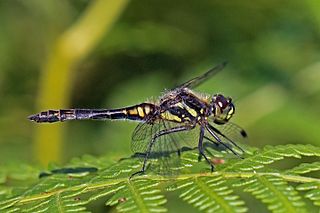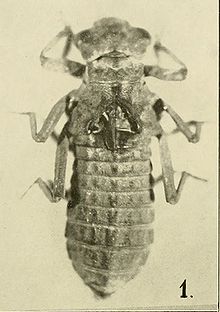
Odonata is an order of predatory flying insects that includes the dragonflies and damselflies. The two groups are distinguished with dragonflies usually being bulkier with large compound eyes together and wings spread up or out at rest, while damselflies are usually more slender with eyes placed apart and wings folded together along body at rest. Adult odonates can land, but rarely walk.

A dragonfly is a flying insect belonging to the infraorder Anisoptera below the order Odonata. About 3,000 extant species of dragonflies are known. Most are tropical, with fewer species in temperate regions. Loss of wetland habitat threatens dragonfly populations around the world. Adult dragonflies are characterized by a pair of large, multifaceted, compound eyes, two pairs of strong, transparent wings, sometimes with coloured patches, and an elongated body. Many dragonflies have brilliant iridescent or metallic colours produced by structural coloration, making them conspicuous in flight. An adult dragonfly's compound eyes have nearly 24,000 ommatidia each.

Damselflies are flying insects of the suborder Zygoptera in the order Odonata. They are similar to dragonflies but are smaller and have slimmer bodies. Most species fold the wings along the body when at rest, unlike dragonflies which hold the wings flat and away from the body. Damselflies have existed since the Jurassic, and are found on every continent except Antarctica.

Enallagma cyathigerum is a species found mainly between latitudes 40°N and 72°N; It is widely distributed in the Palearctic, and the Nearctic species Enallagma annexum was at one time considered to be synonymous with it. The species can reach a length of 32 to 35 mm. It is common in many different countries including Russia, Sweden, Norway, Finland, the United States of America, and South Korea. Damselflies are an important link between the health of the aquatic ecosystem and its response to climate change.

The insect family Coenagrionidae is placed in the order Odonata and the suborder Zygoptera. The Zygoptera are the damselflies, which although less known than the dragonflies, are no less common. More than 1,300 species are in this family, making it the largest damselfly family. The family Coenagrionidae has six subfamilies: Agriocnemidinae, Argiinae, Coenagrioninae, Ischnurinae, Leptobasinae, and Pseudagrioninae.

Pantala flavescens, the globe skimmer, globe wanderer or wandering glider, is a wide-ranging dragonfly of the family Libellulidae. This species and Pantala hymenaea, the "spot-winged glider", are the only members of the genus Pantala. It was first described by Johan Christian Fabricius in 1798. It is considered to be the most widespread dragonfly on the planet with good population on every continent except Antarctica although rare in Europe. Globe skimmers make an annual multigenerational journey of some 18,000 km ; to complete the migration, individual globe skimmers fly more than 6,000 km —one of the farthest known migrations of all insect species.

Epiophlebia laidlawi, the Himalayan relict dragonfly, is one of four species of Epiprocta in the family Epiophlebiidae. They have at one time been classified as a suborder Anisozygoptera, considered as intermediate between the dragonflies and the damselflies, partly because the hind wings and fore wings are very similar in size and shape, and partly because the insect at rest holds them back over the body as damselflies do. These attributes now are known to be misleading however; the genus Epiophlebia shares a more recent ancestor with dragonflies and became separated from other Anisoptera in and around the uplifting Himalayas.

Epiprocta is one of the two extant suborders of the Odonata. It was proposed relatively recently, having been created to accommodate the inclusion of the Anisozygoptera. The latter has been shown to be not a natural suborder, but rather a paraphyletic collection of lineages, so it has been combined with the previous suborder Anisoptera, the well-known dragonflies, into the Epiprocta. The old suborder Anisoptera is proposed to become an infraorder within the Epiprocta, whereas the "anisozygopterans" included here form the infraorder Epiophlebioptera.

Somatochlora, or the striped emeralds, is a genus of dragonflies in the family Corduliidae with 42 described species found across the Northern Hemisphere.

Sympetrum danae, the black darter or black meadowhawk, is a dragonfly found in northern Europe, Asia, and North America. At about 30 mm (1.2 in) long, it is Britain's smallest resident dragonfly. It is a very active late summer insect typical of heathland and moorland bog pools.

Somatochlora sahlbergi, the treeline emerald, is a species of dragonfly in the family Corduliidae. It is found at high latitudes across northern Eurasia and North America, and occurs farther north than any other dragonfly.
Frank Fortescue Laidlaw (1876–1963) was a British biologist, working particularly in the fields of entomology, herpetology, and malacology.

Epiophlebia superstes, the Japanese relict dragonfly, is one of the four species of the genus Epiophlebia, belonging to the family Epiophlebiidae, which is itself the sole living representative of the epiproctan infraorder Epiophlebioptera.

Diphlebia euphoeoides, sometimes spelled Diphlebia euphaeoides, known as the tropical rockmaster, is an Australian species of broad winged damselfly. It is one of a group known as the azure damselflies. It is found in Queensland (Australia) and Papua New Guinea. It typically occurs near lakes, waterfalls or streams at relatively low altitudes, and is occasionally seen near dry pools.

Xanthocnemis zealandica, commonly known as common redcoat damselfly, red damselfly, or red coat damselfly, is one of the most common native New Zealand damselflies. Adult damselflies are often seen flying around vegetation close to streams.

The Stenophlebiidae is an extinct family of medium-sized to large fossil odonates from the Upper Jurassic and Cretaceous period that belongs to the damsel-dragonfly grade ("anisozygopteres") within the stem group of Anisoptera. They are characterized by their long and slender wings, and the transverse shape of the discoidal triangles in their wing venation.
Odonata are insects with an incomplete metamorphosis (hemimetabolous). The aquatic larva or nymph hatches from an egg, and develops through eight to seventeen instars before leaving the water and emerging as the winged adult or imago.

The giant hawker or the gigantic riverhawker, is a species of dragonfly in the family Aeshnidae. It is found throughout Sundaland, having been recorded on Thailand, Peninsular Malaysia, Singapore, Sumatra, and Borneo. It is the type species for the genus Tetracanthagyna.

















